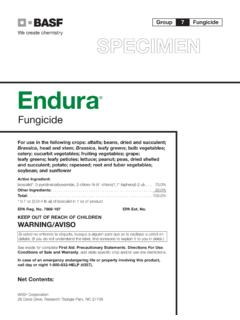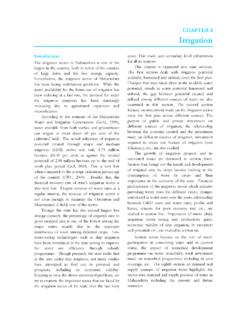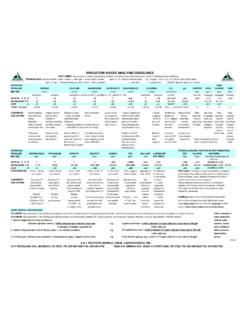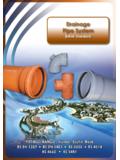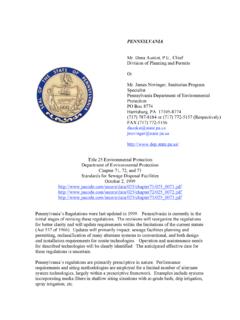Transcription of Production of Tomatoes within a High Tunnel
1 Production of Tomatoes within a High Tunnel Lewis W. Jett1 Department of Horticulture, University of Missouri, Columbia, MO 65211-7140 I. What is a high Tunnel ? A high Tunnel is a solar heated, manually vented, plastic-covered cold frame that is used to lengthen the traditional growing season for many horticulture crops. High tunnels, often called hoophouses can significantly increase the average daily temperature and protect the crop from wind, rain, snow, hail, insects and diseases. High tunnels are not greenhouses, and thus require no electrical connections for ventilation and supplemental heat.
2 A single or double layer of plastic can be attached to bows spaced 4-6 feet apart. The crop is grown directly in the soil using raised beds or mulch depending on the type of vegetable. Drip irrigation is essential for providing water and nutrients to the crop during the growing season. Most high tunnels have roll-up sidewalls and detachable endwalls for temperature and humidity management. Figure 1. University of Missouri high tunnels, Columbia, MO. Each high Tunnel is 20 width x 9-14 height x 36 length.
3 Roll-up sidewalls and detachable end walls provide ventilation and temperature control. Many vegetable crops can be successfully grown within a high Tunnel . Tomatoes are particularly well adapted to culture within a high Tunnel since Tomatoes can be trained to grow vertically by trellising or staking. Early season Tomatoes also reward growers with premium prices since it is difficult to consistently harvest field Tomatoes before July in the central Great Plains. II. Production Inputs for High Tunnel Tomatoes : A permanent high Tunnel should be placed on fertile, non-shaded, well-drained soils with a pH in the range of Since high tunnels are manually vented, they should be placed in an accessible location.
4 The soil should be tilled to a depth of approximately 6-8 inches, and nutrients applied based on a recent soil test. Tomatoes should be established on a raised bed. Raised beds will significantly enhance soil warming, drainage and volume of soil for rooting. An ideal raised bed should be about 8-10 high with 30-36 width at the top. Typically, a 20 x 96 high Tunnel will accommodate five rows of Tomatoes . Raised beds can be made with power tillers or compact bed shapers. After the raised beds are formed, fertilizer, drip tape and plastic mulch can be applied (Figure 2).
5 1 Assistant Professor and State Vegetable Crops Specialist, Department of Horticulture, University of Missouri-Columbia 65211-7140. E-Mail: Figure 2. Raised bed with black plastic mulch (1 mil, embossed). Drip tape is placed under the plastic mulch. For early tomato Production , black, clear or IRT (infrared transmitting) mulch can be applied to increase soil temperatures, reduce weed emergence and soil evaporation. For maximum effectiveness, black plastic mulch should have good contact between the mulch and the surface of the bed for effective transfer of heat.
6 Embossed plastic mulch will fit tightly over the bed. Clear plastic will increase soil temperatures significantly more than black plastic, but weeds will emerge under the clear film (Table 1). White plastic (white on black or white) will significantly lower soil temperatures and can be used for late summer or fall high Tunnel tomato Production . Table 1. Plastic mulch effects on soil temperature1 Mulch Type Soil temperature increase (+) or decrease ( ) ( F) Black +5 Clear +8-14 IRT2 +5-10 White 2 1 Soil Temperature at the 2 depth.
7 2 Infrared transmissible Source: Penn State University Center for Plasticulture and University of Missouri. Organic mulches such as straw, hay or compost can be used for high Tunnel Tomatoes . Organic mulches create a favorable environment for many beneficial insects while increasing organic matter. However, some organic mulches (straw or hay) can significantly lower soil temperature and thus would not be effective for warming the soil in the spring.
8 Compost can increase soil temperatures, but not as effectively as black plastic mulch. Organic mulches can be applied when the soil temperatures have increased. Since the high Tunnel excludes natural rainfall, irrigation must be provided. Drip irrigation for Tomatoes will significantly improve marketable yield and overall quality. A uniform application of water will reduce fruit cracking and other physiological problems such as blossom end rot. The drip tape (a small, collapsible tube) should be buried slightly below the soil 2-3 inches to the side of the plant with the drippers on the top.
9 Eight or 10-mil tape is acceptable with drippers spaced 4-12 apart. A drip system operates at 8-15 psi pressure. For a list of regional drip irrigation suppliers, consult the Appendix. Tomatoes use a large volume of water, particularly during fruit sizing. The fruit is approximately 95% water. From fruit set to harvest, approximately 1 -2 quarts of water per plant may be needed each day. One technique to monitor soil moisture is to use a tensiometer. A tensiometer is a device that measures soil moisture tension as centibars (cb).
10 The drier the soil becomes the higher the centibar reading from the tensiometer. Generally, for Tomatoes , the soil moisture tension should be maintained between 10 and 20 centibars. When soil moisture tension exceeds 20 centibars, irrigation should occur. An additional advantage of drip irrigation within a high Tunnel is the ability to inject water-soluble nutrients through the drip lines as the plant needs them. Generally, large quantities of phosphorus and potassium should not be applied through the drip system.
